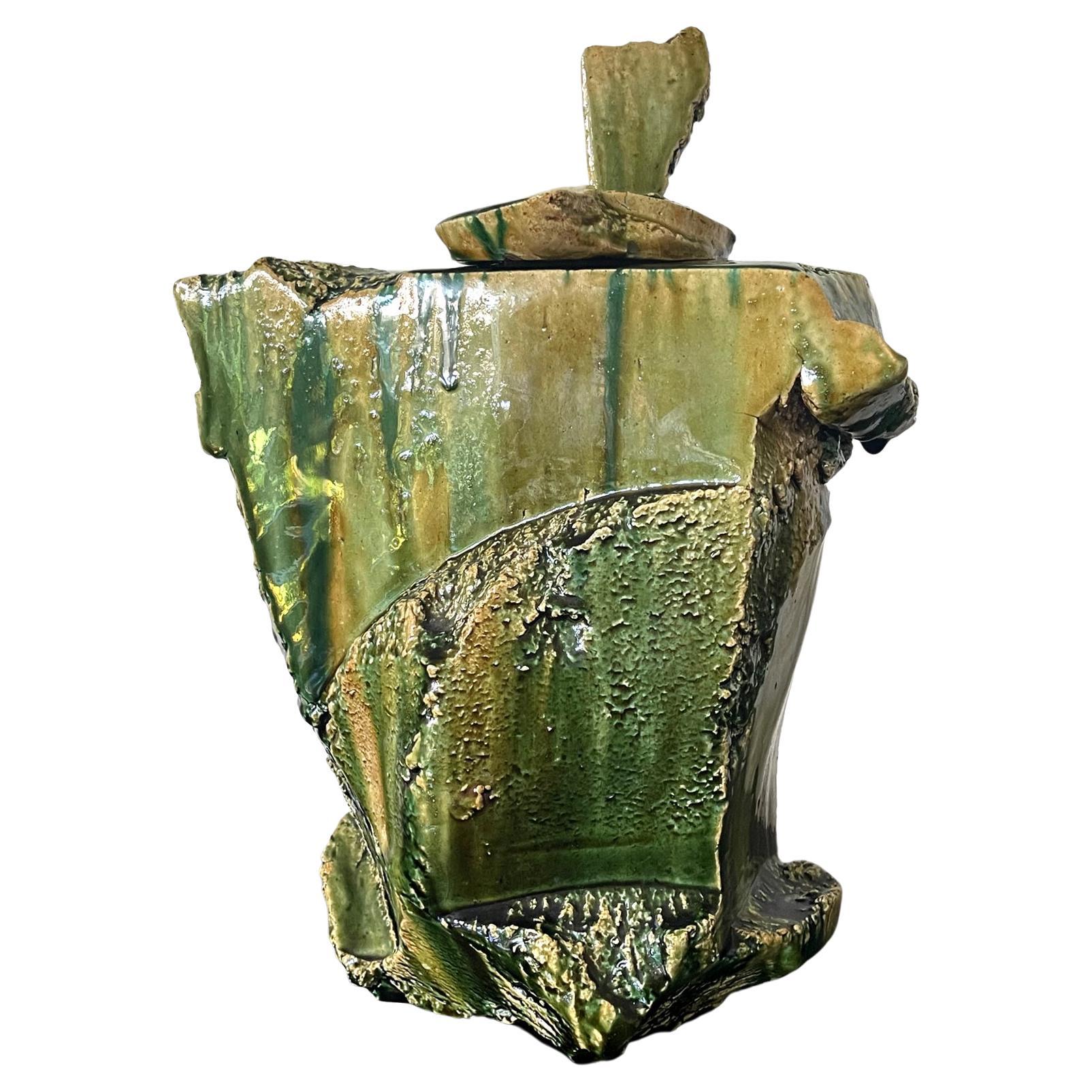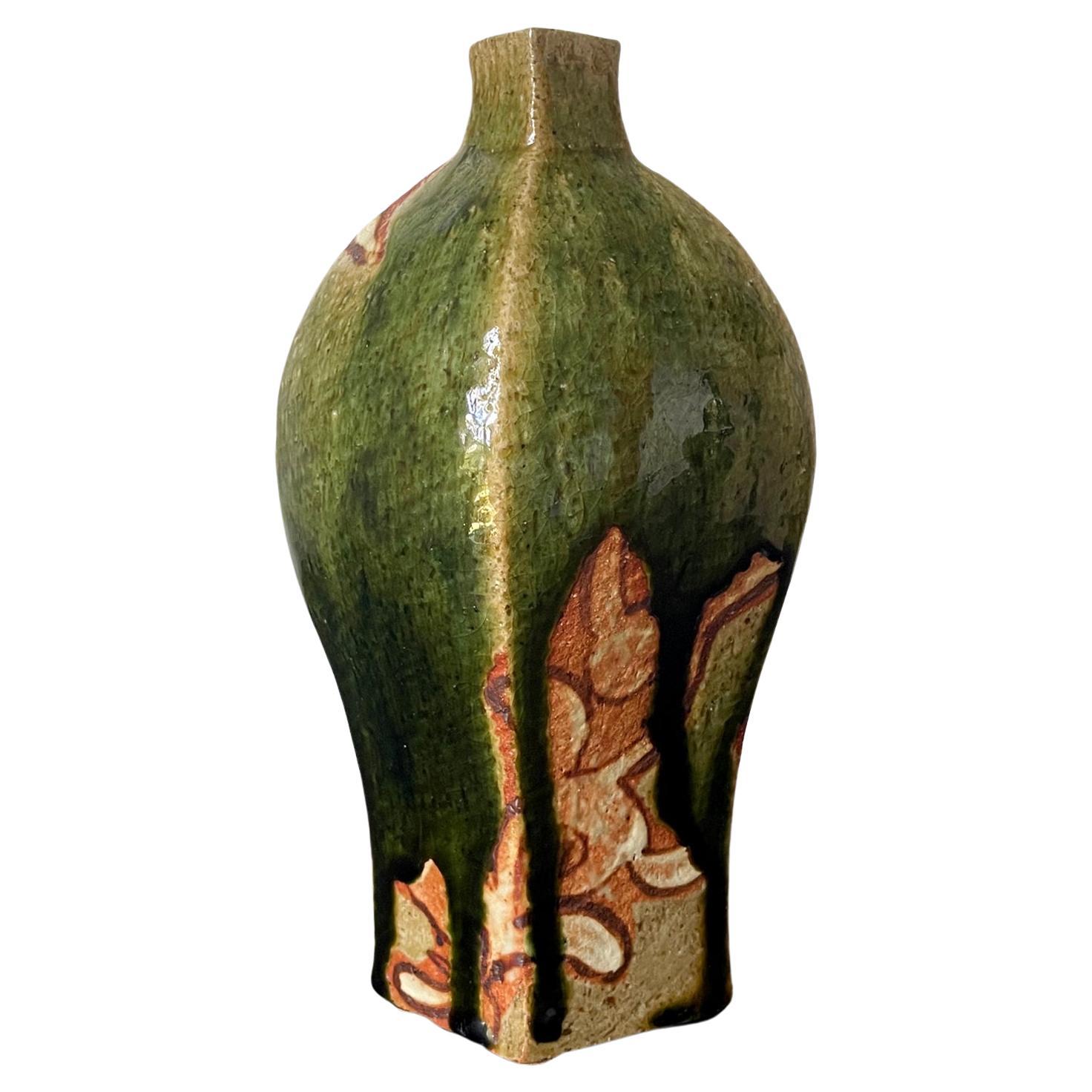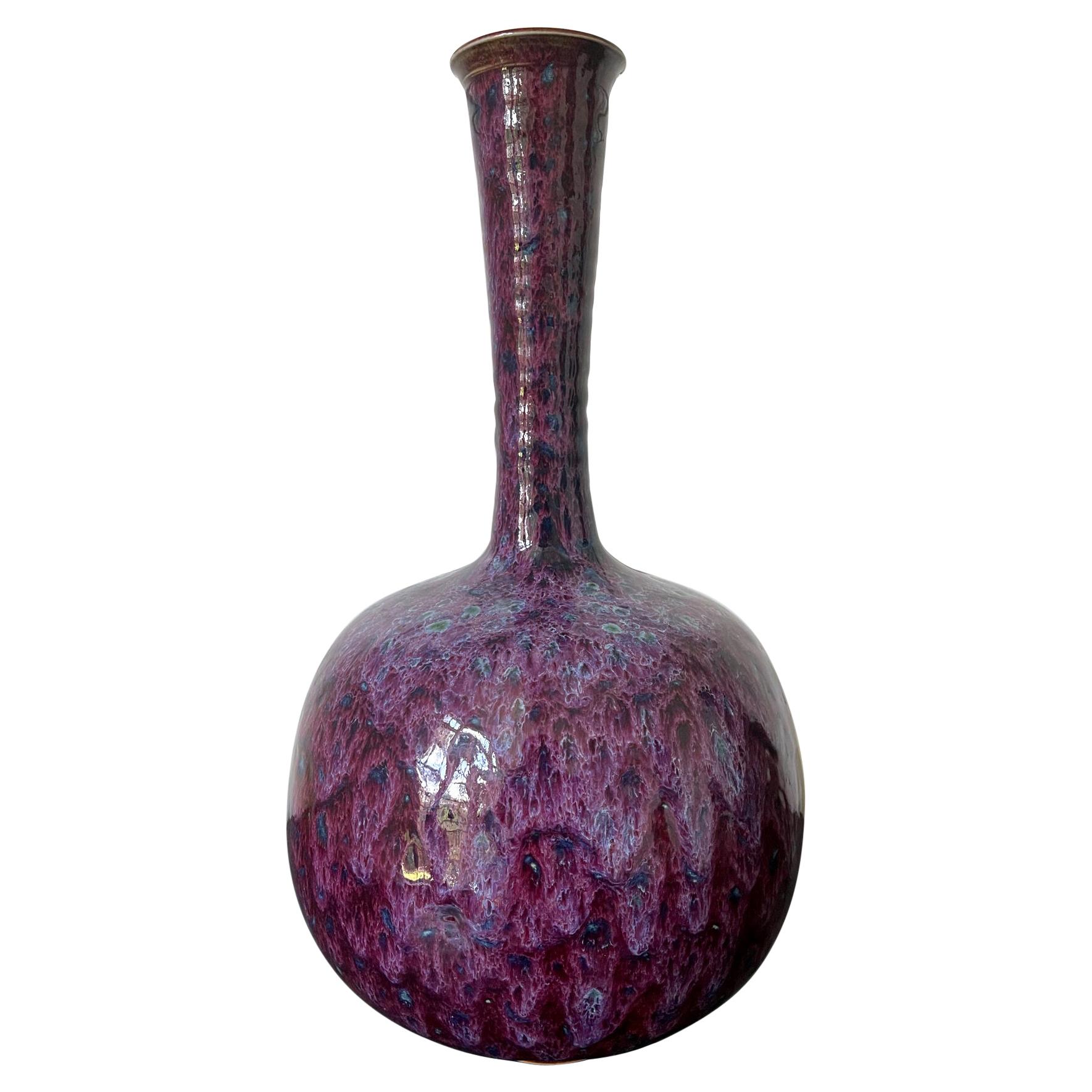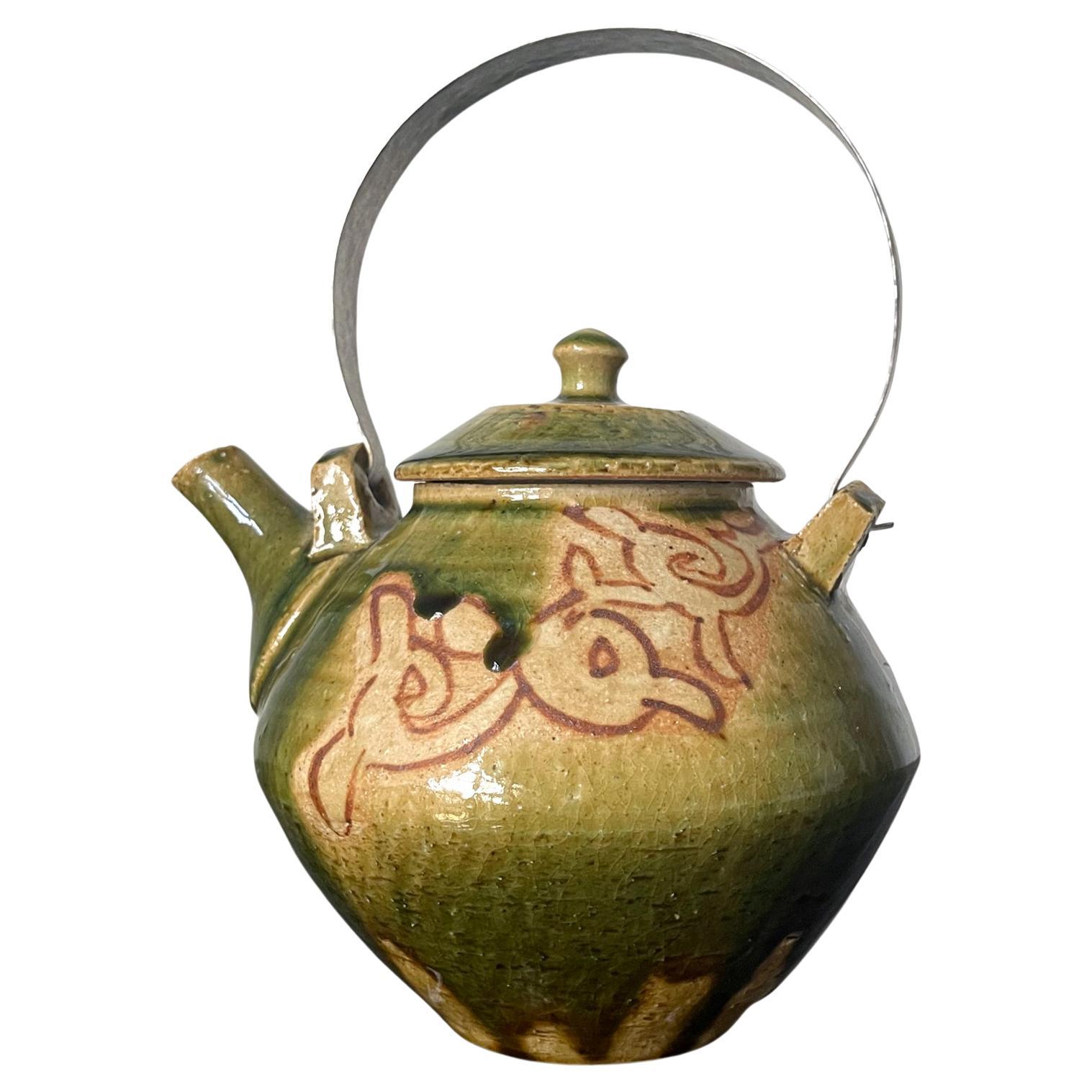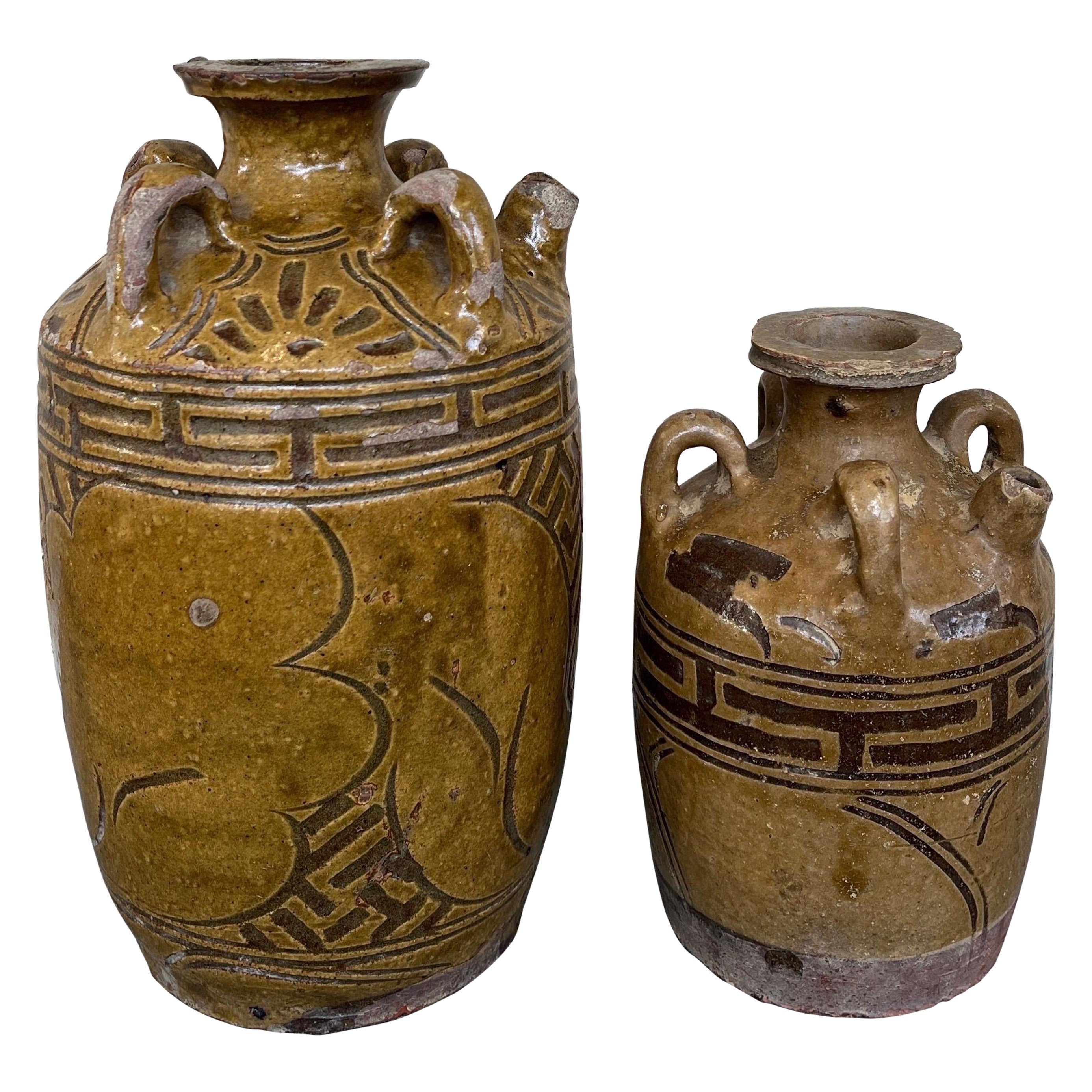Items Similar to Large Sculptural Ceramic Vessel by Mihara Ken
Want more images or videos?
Request additional images or videos from the seller
1 of 14
Large Sculptural Ceramic Vessel by Mihara Ken
About the Item
A large ceramic vessel in an impressive geometrical form by Japanese potter Mihara Ken (1958-) made in 2007. This multi-fired stoneware in shape of a mountain features natural glaze, distinguished scored vertical lines and scattered surface coloration in blue. Signed with artist's mark Ken underneath the base.
Mihara Ken was born in 1958 in Shimane Prefecture, Japan. He is now one of the most renowned Japanese ceramists today. Hailing from Izumo, home to mystic landscapes that gave birth to the great majority of Japan's legends, Mihara's works call to mind the spiritual aesthetics of ceremonial vessels. Yet at the same time, his ceramics embody a deeply introspective and Zen tranquility. Detailed biography available upon request.
Provenance: Joan B. Mirviss Ltd., New York. Exhibited in "Mihara Ken, a new beginning" 05/29-07/03, 2008.
Work in this series are in the collection of Minneapolis Institute of Art collection no. 2013.29.1156.
- Dimensions:Height: 15.75 in (40.01 cm)Width: 24 in (60.96 cm)Depth: 10 in (25.4 cm)
- Style:Modern (Of the Period)
- Materials and Techniques:
- Place of Origin:
- Period:
- Date of Manufacture:2007
- Condition:Wear consistent with age and use. Fine condition with intended surface effect.
- Seller Location:Atlanta, GA
- Reference Number:1stDibs: LU945025428672
About the Seller
5.0
Platinum Seller
These expertly vetted sellers are 1stDibs' most experienced sellers and are rated highest by our customers.
Established in 2006
1stDibs seller since 2010
479 sales on 1stDibs
Typical response time: <1 hour
- ShippingRetrieving quote...Ships From: Atlanta, GA
- Return PolicyA return for this item may be initiated within 2 days of delivery.
More From This SellerView All
- Large Japanese Ceramic Oribe Sculptural Vessel by Shigemasa HigashidaLocated in Atlanta, GAA large ceramic lidded vessel with striking sculptural form by contemporary Japanese potter Shigemasa Higashida (1955-). Hand-built and with drasti...Category
Early 2000s Japanese Modern Ceramics
MaterialsCeramic
- Japanese Studio Ceramic Vase by Ken Matsuzaki with Original TomobakoBy Ken MatsuzakiLocated in Atlanta, GAAn impressive stoneware bottle form vase by contemporary Japanese studio potter Ken Matsuzaki (1950-) circa 2010s. The solid form takes its cue from Chinese traditional plum vase (Meiping) with raised and swelled shoulder and a small opening, yet it rises from a non-conventional pentagonal faceted base. The extraordinary surface was covered with Yohen Shino glaze in a deep iron hue. Thick white slips were applied in bold strokes to the lower portion of the vase. The abstract pattern calls to mind of the imagery of the iconic ocean waves found in traditional Japanese art. The presence of the vase is strong and none-compromising, reaching back to the past yet appearing utterly modern. It is marked by the artist underneath and comes with the original tomobako with title and author inscriptions and a wrapping cloth with the artist's seal. "Ken Matsuzaki’s haptic ceramics bring a contemporary approach to traditional Japanese ceramicware, most notably 16th-century Oribe pottery...Category
21st Century and Contemporary Japanese Modern Ceramics
MaterialsCeramic
- Modern Japanese Studio Pottery Oribe Vase by Ken MatsuzakiBy Ken MatsuzakiLocated in Atlanta, GAA contemporary studio ceramic vase made by Japanese potter Ken Matsuzaki (1950-). The vase showcases a geometrical spindle form, rather distinguishingly modern. It is covered with a thick dripping Oribe green glaze partially revealing the unglazed part of the body, which is decorated with scrolling pattern in left by ash glaze. The work is rooted in both Yohen Shino glaze technique and Oribe tradition, but it is an innovative reinterpretation of the ancient aesthetic. The base is marked with the artist's signature. The vase comes with an inscribed tomobako storage box with the artist's bio and wrapping cloth with seal. The vase measures 9"h x 5.5"w x 4"d. Ken Matsuzaki’s haptic ceramics bring a contemporary approach to traditional Japanese ceramicware, most notably 16th-century Oribe pottery...Category
Early 2000s Japanese Modern Ceramics
MaterialsCeramic
- Large Ceramic Vase by Brother Thomas BezansonBy Brother Thomas BezansonLocated in Atlanta, GAAn impressively large ceramic vase with a bulbous body and a long coiled neck by potter Brother Thomas Bezanson (1929-2007). The minimalist modern form might be distilled from the classic Chinese garlic bottle. The high glossy surface displays a splendid shades of dark purple, copper red, auberge and blue, in a copper flambé pattern called "peacock" glaze that was clearly inspired by ancient Jun Kiln...Category
Late 20th Century American Modern Vases
MaterialsCeramic
- Modern Japanese Studio Pottery Oribe Tea Pot by Ken MatsuzakiBy Ken MatsuzakiLocated in Atlanta, GAA contemporary studio ceramic tea pot with metal handle made by Japanese potter Ken Matsuzaki (1950-). The stoneware tea pot showcases a thick dripping Oribe green glaze partially revealing the unglazed part of the body, which is decorated with scrolling pattern of ash glaze. The work is rooted in both Yohen Shino glaze technique and Oribe tradition, but interestingly it also paid homage to Sancai pottery...Category
Early 2000s Japanese Modern Ceramics
MaterialsCeramic
- Modern Japanese Studio Pottery Oribe Moon Flask Vase by Ken MatsuzakiBy Ken MatsuzakiLocated in Atlanta, GAA contemporary studio ceramic vase made by Japanese potter Ken Matsuzaki (1950-). The vase showcases distinguished "moon flask" form with shoulder loops. The moon flask form was widely recorded first in Tang Dynasty China, most likely arrived from the Mideast countries via the silk road. It was originally used as drink vessel for the nomads and the loops were used to tie it to the horse-centered owner. The exotic form persisted in Chinese ceramic production through Ming to Qing dynasty. The form is unusual in Ken Matsuzaki's work. The artist covered the vase with a thick dripping Oribe green glaze partially revealing the unglazed part of the body, which is decorated with scrolling pattern in left by ash glaze. The work is rooted in both Yohen Shino glaze technique and Oribe tradition, but interestingly it also paid homage to Sancai pottery in Tang Dynasty when green glaze was prominently used to drip and splash onto the pottery. Viewing the vase, one can see in this harmonious piece, the innovative reinterpretation of ancient aesthetics that cross the cultures, geology and time. The base is marked with the artist's signature. The vase comes with an inscribed tomobako storage box with the artist's bio and wrapping cloth with seal. The vase measures 8.6"h x 7"w x 2"d. Ken Matsuzaki’s haptic ceramics bring a contemporary approach to traditional Japanese ceramicware, most notably 16th-century Oribe pottery...Category
Early 2000s Japanese Modern Ceramics
MaterialsCeramic
You May Also Like
- Set Of Two Antique Chinese Ceramic Wine VesselsLocated in New York, NYA truly attractive and unusual set of two antique Chinese ceramic wine jars. Each piece displays a similar glaze, hand painted decoration and is of related design, with four handles...Category
Antique Late 19th Century Ceramics
MaterialsCeramic
- Large Organic Sculptural Ceramic Pottery VesselLocated in San Diego, CAFantastic Post Modern Studio Pottery Vase Vessel. Acquired vessel from an incredible artist estate in Palm Springs, Vase is in excellent vintage condition and believed to be early 1...Category
20th Century American Post-Modern Vases
MaterialsPottery, Ceramic
- Monumental Bombay Glazed Ceramic Vessel with Iron Frame, Late 20th CenturyLocated in View Park, CAA massive art pottery Bombay glazed vase, late 20th century. A broad tear-shaped vessel sits upon a metal stand - two separate pieces. Tones of oxblood, aubergine, and flame-blue. Po...Category
Vintage 1980s Anglo-Japanese Ceramics
MaterialsMetal
- Large Antique Chinese Ceramic Wine JarLocated in New York, NYA nicely glazed, tall antique Chinese ceramic wine jar with a wide mouth and graceful shape. From Shanxi Province, circa 1920. CR714.Category
Early 20th Century Chinese Ceramics
MaterialsCeramic
- Modern Large Scale Neolithic Style Ceramic PotsLocated in Los Angeles, CATwo modern Neolithic style Chinese ceramic pots. Sold separately. Large pot has a small hairline crack on the bottom that has been repaired. please...Category
20th Century Chinese Neoclassical Urns
MaterialsCeramic
- Gio Ponti Large Green Vase in Ceramic by Richard Ginori 1930s ItalyBy Richard Ginori, Gio PontiLocated in Montecatini Terme, ITLarge vase in green ceramic designed by the Italian designer Gio Ponti and manufactured by Richard Ginori between the 1930s and the 1940s. In this piece, the ceramic was modeled with an elegant and raffinate, flared shape that makes it a perfect decorative vase. The manufacturer's brand is stamped under the base. The history of the Ginori Manufactory began in Doccia, just a stone's throw away from Florence, when in 1735 Marquis Carlo Andrea Ginori started a porcelain factory which was destined to become a worldwide icon of style. The eighteenth-century is a key century for the development of porcelain in Europe, in this period the first manufactures are born, fed by new styles and international trends. In stately homes, palaces and courtyards, the precious porcelain of the Doccia Manufactory is synonymous with elegance and refinement. The passage from the nineteenth, the century of reason to that of feeling marks a new chapter in the development of artistic taste and the manufacture of porcelain. Florence becomes the scene of a controversy between the academic supporters of the Beautiful ideal and the naturalists promulgators of the beautiful natural Since 1806 the direction of the Manifattura passed to Leopoldo Carlo Ginori Lisci who initiates a process of profound renewal. In 1986 The Manifattura expanded and the Richard Ginori Ceramic Company is born. The tradition of master craftsmen meets new technologies and the creations are perfected thanks to the use of new patents From 1923 to 1933 the artistic direction of the Manifattura was entrusted to Gio Ponti. The master is responsible for introducing highly innovative elements with sensitivity and respect for the taste for the ancient, and for the oriental culture. In 1925 at the Universal Exposition in Paris, the Manifattura and its artistic director were awarded the assignment to both of a Grand Prix. The Manufactory was renewed by relying on the experience of the greatest Italian designers of the time: Franco Albini, Franca Helg, Antonio Piva, Sergio Asti, Achille Castiglioni, Gabriele Devecchi, Candido Fior...Category
Vintage 1930s Italian Mid-Century Modern Vases
MaterialsCeramic
Recently Viewed
View AllMore Ways To Browse
Large Sculptural
Large Ceramic Vessel
Large Blue Ceramic
Sculptural Ceramics
Glazed Large Ceramic Base
Japan Made Ceramic
Ceramic Sculptural Vessel
Japanese Ceramic Collections
Japanese Signed Ceramic
Modern Asian Ceramics
Large Sculptural Vessel
Asian Large Vessel
Used Furniture Minneapolis
Glazed Asian Vessel
Natural Mystic
Asian Brown Stoneware
Joan Potter
Mihara Ken
